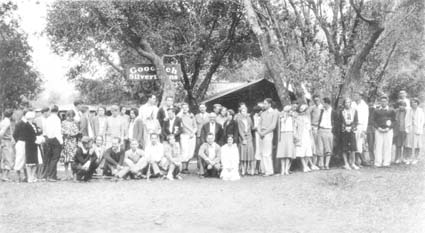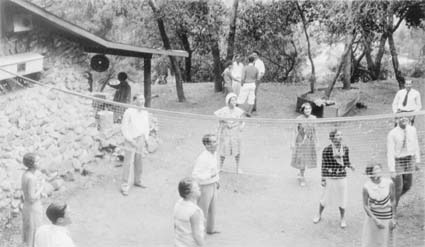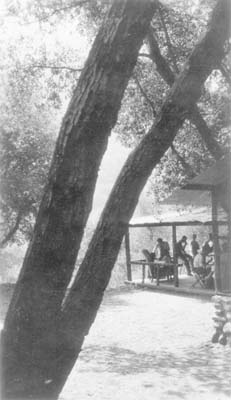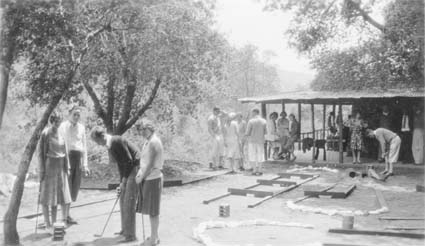|
Nu Alpha Phi NAP Home Member E-mail Events History Cabin Pay Dues Oak Leaf Current Issue Editorial NAP Network Odds and Ends In Memoriam NAP / Cabin History Clarence Lee Archives About/Masthead Send News Other FAQ Free E-mail Update Your Address E-mail NAP Links |
NAP /
Cabin
History
[Excerpted and adapted from a presentation titled “The Early Years of Nu Alpha Phi” Bob Dozier '23 #3 made at the 70th birthday party of NAP. Originally published in the June 1991 Oak Leaf. Photos are all from Fraternity Day, 1930. –Ed.] Nu Alpha Phi was founded on March 21, 1921. Soon after, unable to find a suitable site at Camp Baldy where the other three local fraternities had their cabins, NAP chose a hilltop site in San Dimas Canyon, on Angeles Forest land, upstream from the proposed San Dimas Flood Control Dam. Building the cabin became the unifying influence for the new fraternity and resulted in the close and abiding friendships of those early years. In the Fall of 1921 NAP's ranks increased to 16 and the floods of early December washed out the new road around the proposed lake and it was impassable until February because of slides and fallen trees. Or nearly so. While the storms prevented any work being done, several Nu Alphs, Bob Dozier among them, went to the cabin on December 20. It was necessary to hike a couple of miles from the Mountain Sprint Ranch above Foothill on the canyon's east side. Construction began in earnest during spring vacation, 1922. We pitched our camp under direction of Chef “Fish” Powers on the meadow below the Moose Lodge at the foot of our hill. In the half-tent beside his Ford was the pantry and also a cot for the chef himself, probably to guard the cookies. A table and bench were improvised, and a piece of heavy boiler plate served as the stove top. This plate later was mounted on the outside rustic stove at the cabin. The table became part of the corrugated iron roof. There was plenty of wood for fuel. A new main road up the North Fork of the stream was built by the rangers on the other side of the stream, leaving the old road on our side virtually private. That was helpful because “Primitive,” Joe Caldewell's old progressive shift Maxwell, used our strip of road so constantly. Also the tents which had been used by the road gang were still there in our meadow camp. These were a welcome shelter for us in the cold and foggy weather. A day or more of time was spent falling trees in the meadows at the head of the future lake. These were used later as posts to hold up the porch roof of the cabin. But the main job was to collect rocks. Just lots and lots of rocks. We carried them from the stream bed to a tree beside the road near the foot of the trail. We competed with each other to carry the biggest rock we could lift. I think Wes was a champion in this which no doubt was great preparation for earning his Ph.D. at Harvard. We rented a team of mules, then borrowed a team of horses and wagon from Mr. Martin who lived across the stream so we could carry more rocks from greater distances. Our mason estimated that we collected 90 tons of rocks. We also bagged sand at the stream bed to mix with the cement. The rocks, several hundred bags of cement, and later the lumber and roofing, had to be carried up to the construction site on the top of the knoll. We could not carry all of this up the trail on our backs. We strung a wire cable from the tree where we piled the rocks to another at the crest of the hill, still some 40 yards from the building site and built a box to hang from a pulley on the cable. A rope from the box ran through a pulley at the upper tree and back through a pulley anchored in the road. The rope then was tied to the rear of “Primitive.” On signal when the box was full, the driver ran “Primitive” rapidly in low gear to a marked point in the road. The top crew emptied the box, gave a signal, and “Primitive” was returned rapidly in reverse to the starting point. On two trips, the rope broke, and the full box came racing down the cable, the tree shuddered, and the rocks went flying clear across the creek. When the second box was being built, Biddle and Powers invented an improvement. The bottom of the box was hinged and held closed by an angle iron at the front. This hook could be opened with a pick, dropping the load. This simple dumping arrangement literally “made the cabin possible.” From the upper dump site the rocks and other material were again carried by hand. Even with the dumping device, each rock was handled at least seven or eight times. On one memorable occasion the intrepid Caldwell climbed into the box and made the aerial trip. A new rope had just been installed and all went well, but there were no other volunteer passengers! Another major component of concrete mortar is water. We found and developed a small spring below our site and above the Moose Lodge. It was on our leased property, but Mr. Buxton, the ranger, moved our lease line, putting the spring on public property. This was very convenient to the Moose Lodge which could get water by gravity flow. So we bought a 4-cylinder hand pump, operated by two men. The spring flowed into two barrels then we pumped it up through 100 feet of old water pipe which we confiscated from somewhere, and on through a hose into two barrels at the cabin site. The mason worked on the rock walls for several weeks and needed four or five barrels of water per day, so it was necessary for two men to drive from Claremont at least twice a day to keep his water supply adequate. Joe Caldwell secured the services of a Claremont masonry contractor named Preston Taylor, “Press.” Gradually the walls grew higher, and door and window framers were set in place. These were made for us by the father of Ed Anderson '23, a fine carpenter. Fannie Boyd and Phyllis Stephens were the first girls to see the cabin in process of construction. By Frat Day, May 30, 1922, the stone work was completed, interior cement floor laid, and windows and doors installed. Chan's mother presented a Guest Book which was signed by about 60 guests. Some of the guests were Caldwell, Ray Livengood and his guest, Doris Packard (later Joe's wife) and Fannie.  In the morning we had a ball game between the girls and the boys on the former camp site. I can find no record of the score! In the evening we all gathered in the cabin and President Caldwell lit the first fire in the wide fireplace.  It was a time of rejoicing and recognition of the mental and physical energy involved in doing so great a task in so short a time. After having lost by graduation six of the Charter Members who were in the 1921 group picture, the Actives had grown to 20 for the official spring, 1922 picture. These were the group of whom it can be said, “They built the cabin.” But there was still much to be done. During the fall of 1922 about 3000 square feet of corrugated iron roofing was laid, covering all but the porch on the east end. The piles of dirt from grading were disposed of and frames for 12 bunks were built in the sleeping porch.  Several other jobs of considerable size were completed during the spring, 1923 holidays. The roof was completed over the east end. Rafters were stained green and porch posts treated with oil. The lower half of the trail was rebuilt to make a more gradual climb. A partition was built in the kitchen to create a store room and storage shelves. “Press” Tayler came back to lay the 600 square feet of cement floor on the entire porch. This required the hauling of sand and cement and the pumping of water again. We also developed a spring in the steep canyon back of the cabin to get a small water supply for the kitchen. Then along came a group of girls who, including Louise and Fannie, it may be said, were rather interested in Nu Alpha Phi boys. They added touches of beauty and comfort to the cabin, including curtains. When these were ready, half a dozen couples went to the cabin on a Sunday and hung the curtains. Some of these couples married: Leighton, Dozier, Caldwell, Biddle, Thomas, and Anderson. It is interesting to recall today, 70 years after the events described here, that most of the early members were working to pay their way though college. It was necessary to have money to buy materials and to hire a mason, and money was scarce. Some of the Charter Members had earned the friendship of Major Vogdes, who had been the Commandant of the Pomona College SATCH (Student Army Training Corps) in the last years of World War I. He loaned them $1,000 which was a sum beyond the reach of the fraternity members. This was the only outside financing of the cabin construction, and it is my recollection that this load had been paid off by 1923. In February, 1923, as the cabin neared completion, the first Cabin Rules were issued. They set up a date book for reservations for party groups and standards for maintenance of the property. Fraternity Day, May 30, 1923, was a merry day. The seniors and alumni and guests arrived the evening before. The ladies spent the night in the cabin. The men arranged for lodging at a cabin in the West Fork. The ball game was played in our own back yard. There was ample room in the cabin and on the grounds to entertain a crowd of over 70 persons.  The senior members installed on the front door a brass plate engraved with the Nu Alpha Phi coat of arms -- the acorn -- bearing two dates: March 21, 1921 for the founding of the fraternity, and May 30, 1923, for completion of the cabin. Early in 1923, Billy Ament left the faculty for another college and Dr. William Kirk replaced him as one of our faculty members. The annual photograph included 22 members for the year 1922-3. This is the group who “carried on” for the completion of the cabin structure. But of course, the building of the cabin, like the building of the fraternity, and the building of the college is never complete. The cabin and the fraternity go on serving each other, creating lasting friendships, establishing goals, and then striving together to achieve them, teaching us to consider true friends as brothers, to the honor and the glory of Nu Alpha Phi. | |||
| Top | Previous | Contents | Next | |